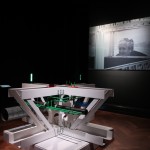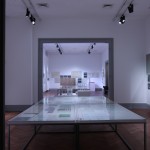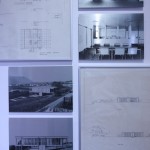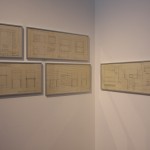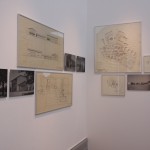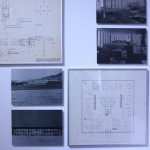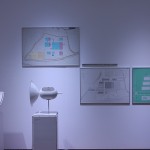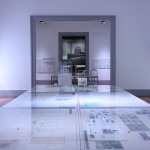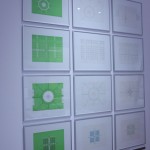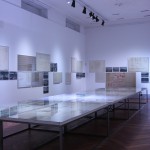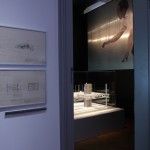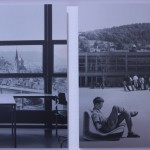Fritz Haller. Architect and Researcher at the Swiss Architecture Museum Basel
Until August 24th the Swiss Architecture Museum, SAM, in Basel is staging “Fritz Haller. Architect and Researcher”, an exhibition devoted to one of the most important architects and architectural theorists of the 20th century, albeit one who is all too often overlooked and misunderstood. Or simply known for his USM modular storage system.
Born in Solothurn, Switzerland in 1924 Fritz Haller trained as an architectural draughtsman before undertaking a series of jobs in architecture firms throughout Switzerland. Following a study tour to Rotterdam in 1948/49 Fritz Haller returned to Solothurn where he established an architecture practice with his father Bruno, a practice that over the next two decades realised numerous projects across Switzerland and which was fundamental in establishing the so-called Solothurn School, one of the defining movements in Swiss modernist architecture. In 1968 Fritz Haller travelled to America to begin a tenure as Guest Professor at Konrad Wachsmann’s Institute for Building Research at the University of Southern California, Los Angeles before in 1977 taking up a position as Professor in the Institute for Industrial Building Production at the University of Karlsruhe, a position he held, and combined with freelance architectural work, until 1992. Fritz Haller died in Solothurn in 2012.
Curated by SAM director Hubertus Adam and Professor Georg Vrachliotis from the University of Karlsruhe the Basel exhibition is part of a triumvirate of events dedicated to the life and work of Fritz Haller, and follows an academic symposium held in Zürich in 2012 and precedes a Fritz Haller monograph due to be published later this year/early 2015. In addition to original plans and sketches by Fritz Haller and examples of his most important publications, the exhibition also presents models, newspaper articles, magazine articles and letters from, to, by and about Fritz Haller which all combine to create a very accessible, logical and for all lively portrait of the man and his work.
Covering neigh on five decades of Fritz Haller’s work as both a practising architect and empirical researcher the exhibition is unavoidably wide in scope but does thankfully take regular detours to explore particularly relevant and/or interesting aspects of his work in more depth, for example, his Space Colony project, his relationship with Konrad Wachsmann or some of his key buildings, including one section specially devoted to Haller’s numerous school projects: a section in which we learn that, as with so many architects of his generation, Fritz Haller also designed furniture for his projects. Not particularly comfortable looking school furniture it has to be said, but certainly very functional looking school furniture.
Perhaps the most interesting excursion the exhibition takes is that devoted to the ARMILLA software system Fritz Haller developed while at Karlsruhe and which is and was one of the first architectural planning software systems. As the exhibition makes clear it was thanks to ARMILLA that Haller was able to plan the modularity of his buildings in that the technical systems, gas, water, air conditioning etc, were also planned as modular features. Thus ultimately allowing the development of his much celebrated Midi Mini Maxi modular construction system.
Although providing an excellent introduction to Fritz Haller, the paradox of the exhibition is that at the same time it places in an ever stronger light two of the conflicts that exist in context of Fritz Haller: his relative public anonymity despite his critical acclaim and respect amongst his colleagues, and why he only realised projects in Switzerland.
Two conflicts the exhibition can’t solve. Or at least not directly.
For co-curator Georg Vrachliotis the anonymity is readily explained, “Fritz Haller enjoyed a quiet fame, those that knew him hold him in high esteem, but for those who didn’t know him it can be difficult to understand the man and his work. He was a experimenter, a seeker, and so not as visible as those architects who create a work and then present it to the public with great fanfare. Through the work he did he simply didn’t have access to a broad public”
Not only a lack of public hindered Haller’s popular acceptance, but also a lot of popular misconceptions, “A major misunderstanding in context of Fritz Haller”, continues Georg Vrachliotis, “is that he wanted to systematise everything. While that is true to a certain extent, ultimately he wanted to develop systems which offered individuals the possibility to develop as they wanted. Haller didn’t believe that systems should restrict society, rather he believed that one can create systems within which individuals could freely move as they wished. Fritz Haller saw the individual as part of a network”
“Work”, proclaims Fritz Haller in one of the many quotes adorning the exhibition walls, “will be done anywhere. In the home, in the bistro, in the train, on the plane. Schools will no longer be schools, rather locations where individuals come together in a network of relationships and data. In particular electronic media will expand our immediate environment beyond all recognition. This global change will without question fundamentally change the built environment”.
Words that not only make it even more inexplicable that Fritz Haller’s work didn’t and doesn’t receive wider popular recognition, but which also remind us of many of the sentiments currently being expressed by Konstantin Grcic in his Panorama exhibition showing at the Vitra Design Museum. The two museums are separated by around 8kms. A compare and contrast is to be recommended.
For Haller’s lack of commissions outwith Switzerland Georg Vrachliotis has no ready answer, but through a presentation of Haller’s entry for the competition for a new Braun factory in the German town of Melsungen the exhibition does show that Haller was interested in working beyond the Swiss borders. James Stirling won the competition. Fritz Haller came second.
In addition to the Fritz Haller’s architectural works Fritz Haller Architect and Researcher also – inevitably ? – devotes a section to System USM Haller. But must the furniture be there? It is after all an exhibition about an architect in an architecture museum. However for Georg Vrachliotis it unquestionably has its place, “We wanted to show how multi-faceted Haller was and that the System USM was a milestone in his biography, but one of many. And presenting a museum exhibition about Fritz Haller without the furniture would not be correct because one would be leaving out something important, something defining, in his career.”
And regardless of whether the USM furniture should be in the exhibition or not, we’re glad it is for it contains a surprise for all familiar with System USM Haller. Or better put, contains a bulky wooden surprise for all who thought they were familiar with System USM Haller. Including us. When first presented to the public in 1965 the reduced metal storage system we all know today was a relatively ugly wood system.
Honest!
While the exhibition design may lack the baubles and glam of, for example, the new permanent exhibition in the State Archaeology Museum in Chemnitz it is a very open, well conceived and well laid out exhibition which offers all with an interest in Fritz Haller and/or contemporary architecture an opportunity to explore and learn at their own pace.
But would Fritz Haller have enjoyed the exhibition, “No!” responds Georg Vrachliotis, smiling broadly, obviously amused at the thought of guiding Fritz Haller through the rooms,”it wouldn’t be to his liking because it doesn’t follow his logic. Both myself and Hubertus Adam were aware of that but as a new generation we have a responsibility to create a new interpretation of Fritz Haller.”
And how is this new Fritz Haller to be read, what does he hope the visitors take with them from the exhibition, “I understand Fritz Haller as someone who was always questioning his environment, and I hope that with this exhibition we can motivate visitors to pose their own questions, about architecture, society, the modern age.”
With Fritz Haller Architect and Researcher the Swiss Architecture Museum have created a system in which the visitor can do just that.
Which would surely, but surely, have pleased a system fanatic such as Fritz Haller.
Fritz Haller Architect and Researcher can be viewed at the Swiss Architecture Museum, Steinenberg 7, 4051 Basel until Sunday August 24th 2014
In addition to the exhibition the museum have organised an accompanying fringe programme. Full details can be found at http://www.sam-basel.org/
- Fritz Haller and a 1:1 scale model of a MIDI construction system as realised with ARMILLA
- Fritz Haller. Architect and Researcher at Swiss Architecture Museum Basel
- Plans and photos from and of the single family houses, as seen at Fritz Haller Architect and Researcher, Swiss Architecture Museum, Basel
- Sketches for school furniture, as seen at Fritz Haller Architect and Researcher, Swiss Architecture Museum, Basel
- Plans and photos from and of various school projects, as seen at Fritz Haller Architect and Researcher, Swiss Architecture Museum, Basel
- Plans and photos from and of the USM Pavillon, Münsingen, as seen at Fritz Haller Architect and Researcher, Swiss Architecture Museum, Basel
- Model of modeules from Fritz Hallers’s Space Colony project and his plans for the Braun factory Melsungen, Germany
- Fritz Haller. Architect and Researcher at Swiss Architecture Museum Basel
- Sketches from Fritz Haller’s “integral urban” books, as seen at Fritz Haller Architect and Researcher, Swiss Architecture Museum, Basel
- Fritz Haller. Architect and Researcher at Swiss Architecture Museum Basel
- Fritz Haller. Architect and Researcher at Swiss Architecture Museum Basel
- Photos from and of the Kantonsschule Baden Baden, as seen at Fritz Haller Architect and Researcher, Swiss Architecture Museum, Basel
Tagged with: Basel, Fritz Haller, USM Haller
